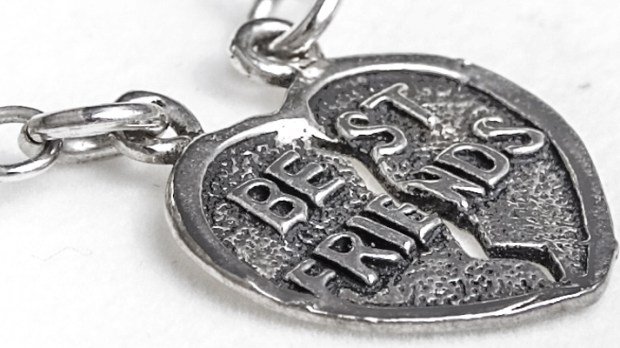Many years ago, shortly before my family moved overseas for a while, a friend of mine gave me a “best friends” necklace. We both had half of a charm to wear around our necks. When we put the two halves together, they formed a complete heart that said “best friends.”
That necklace meant a lot to me. In the middle of the chaos of moving and getting adjusted to a new country, new home and new community, the necklace was reminiscent of familiar things and a friendship I cared about. It made me feel accompanied, known and valued in spite of separation. It reminded me of my friend’s existence and that, even when we were separated, she was still somehow a real part of my life. In my childhood fantasies, I also figured that even if I didn’t see her for many years, and therefore didn’t recognize her the next time I saw her, the necklace would be a way of identifying her.
A friendship necklace is a symbol, or, to use the Greek word, symbolon. In ancient Greek, symbolon referred to a “token,” half of a broken object that could be used for the sake of recognition. A symbolon gave someone the right to be accepted by the party that owned the corresponding half, to be received and granted hospitality.
Symbolon is also the Greek term used for “creed.” The Nicene Creed that we pray each Sunday during Mass is, in many ways, a friendship charm that God has given us to keep us united with him even while we are sojourners in a foreign land, not yet enjoying perfect union with him.
The Creed, our part of the symbolon, is, so to speak, not complete in itself. Its existence signals something beyond it; it points us to the final end God intends for us. As such, it reminds us of what St. Paul tells us: “At present, we see indistinctly, as in a mirror, but then face to face. At present I know partially; then I shall know fully, as I am known” (1 Cor 13:12).
Our creed is an assent of faith, a collection of truths God has revealed to us in order to affirm and preserve our relationship with him, both through our individual faith and through our communal identity as the Church, the Body of Christ. As a defined set of beliefs shared by those who profess it, the Creed unites us with other believers. Our individual profession of faith is not complete on its own, but takes on a fuller dimension when we put it together with that of others and, through the unity of the Creed, recognize each other as part of the same community. Our faith as a community likewise remains a symbolon, a broken half that points us to our need for God and will be completed when we attain eternal union with him.
The Creed’s identity as a symbol doesn’t only remind us of our need for God. It also gives us the security that, if we are faithful to our own identity, true to our symbolon, we will be recognized, accepted and protected. We will receive divine hospitality.
Our Creed, then, is far more than a set of beliefs that we recite every Sunday. Our genuine profession of faith through the Creed serves as a verification of who we are in relation to God. It affirms that we are his children, that we have received and accepted the truths he has revealed to us, that we are part of the people of God, and that we are journeying toward him, with the hope of one day being welcomed into the fullness of eternal life with him.

